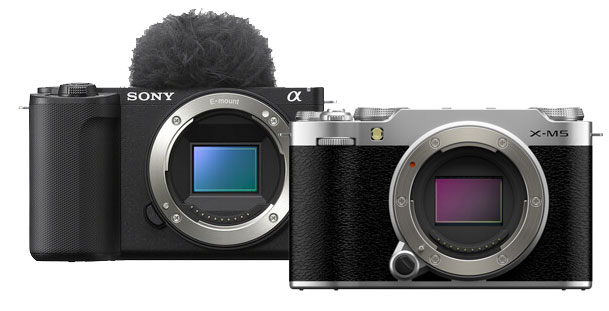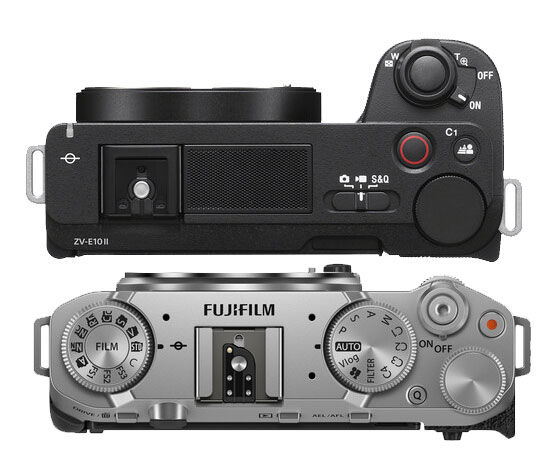
Compare the Sony ZV-E10 II camera against the recently announced Fuji X-M5. We will be comparing the 10 major differences between the two. Not only that, but these are the differences we have sorted out to make it a bit easier to understand instead of putting all comparisons in front of you in a single table. So we have distributed them into 10 different types of tables, so let’s begin.
See more comparisons – Fuji X-M5 vs Sony A6700
1. Camera Design Comparison
| Feature | Sony ZV-E10 II | Fuji X-M5 |
|---|---|---|
| Lens Mount | Sony E | FUJIFILM X |
| Built-In Flash | No | No |
| Display | 3″ Articulating Touchscreen LCD | 3″ 3-Way Tilting Touchscreen LCD |
| Body Material | Plastic Body | Magnesium Alloy |
In the first section, where we compare the camera design and all the details, you can see that the Fuji X-M5 is slightly smaller and a bit lighter than the Sony ZV-E10 II. The biggest advantage I see with the X-M5 is the weather-sealed design and a more durable body
2. Body Weight and Dimensions Comparison
| Feature | Sony ZV-E10 II | Fuji X-M5 |
|---|---|---|
| Body Weight (with battery & media) | 377 g | 355 g |
| Dimensions (W x H x D) | 114.8 x 67.5 x 54.2 mm | 111.9 x 66.6 x 38 mm |
3. Ports Comparison
| Feature | Sony ZV-E10 II | Fuji X-M5 |
|---|---|---|
| HDMI Output | Micro-HDMI | Micro-HDMI |
| Audio Input | 1x 3.5mm Microphone Input | 1x 3.5mm Microphone Input |
| Audio Output | 1x 3.5mm Headphone Output | 1x 3.5mm Headphone Output |
| USB-C | USB 3.2 Gen 1 (Data & Power) | USB-C (Data) |
The next is the ports comparison. More or less, both have similar kinds of ports—micro HDMI input, headphone, and output port, so connectivity-wise both are quite similar to each other.
4. Camera Sensor Comparison
| Feature | Sony ZV-E10 II | Fuji X-M5 |
|---|---|---|
| Sensor Size | APS-C (23.3 x 15.5 mm) | APS-C (23.5 x 15.6 mm) |
| Effective Resolution | 26 MP | 26.1 MP |
| Sensor Crop Factor | 1.5x | 1.5x |
Let’s compare the internal core specifications of the cameras. We have the 26 MP X-Trans sensor on the Fuji side, while the Sony has a 24 MP Bayer pattern BSI CMOS sensor. More or less, we will get similar image quality from both cameras.
No, neither of the cameras has any mechanical stabilization inside them for stills, so you have to be careful while using these cameras.

5. Autofocus Comparison
| Feature | Sony ZV-E10 II | Fuji X-M5 |
|---|---|---|
| Autofocus Points (Photo) | 759 Phase Detection | 425 Phase Detection |
| Autofocus Sensitivity | -3 to +20 EV | -7 to +7 EV |
| Autofocus Modes | Auto, Continuous, Single, Manual | Continuous, Single, Manual |
The autofocus system of both cameras is super awesome. Still, again, since Sony and Canon are leading in autofocus tracking, as well as if you compare the number of phase-detect autofocus points, the Sony ZV-E10 II has 759 AF points, while the X-M5 remains limited to 425. So, more or less, the tracking performance coming straight out of the Sony camera will be more usable and reliable compared to the Fuji X-M5.
6. Image Stabilization Comparison
| Feature | Sony ZV-E10 II | Fuji X-M5 |
|---|---|---|
| Image Stabilization (Photo) | No | No |
| Image Stabilization (Video) | Digital, Active IS, Gyro | Digital IS |
On the other side, we have better autofocus sensitivity in the Fuji X-M5, which means the ability to lock focus in backlit situations is better with the X-M5. But again, AF sensitivity doesn’t help much with tracking performance. So both are completely different in terms of tracking and sensitivity. Generally, we rely more on tracking performance rather than sensitivity.
7. Continuous Shooting Speed Comparison
| Feature | Sony ZV-E10 II | Fuji X-M5 |
|---|---|---|
| Max Continuous Shooting | 11 fps (Photo) | 30 fps (Photo with electronic shutter) |
| Max Frames in Burst | 59 (RAW) / 1000 (JPEG) | 23 (RAW) / 128 (JPEG) |
The X-M5 offers 30 fps continuous shooting with the electronic shutter but with some crop. If I select the uncropped mode, the speed drops to 20 fps, which is still better than the Sony ZV-E10 II’s 11 fps continuous shooting mode.
8. Video Resolution Comparison
| Feature | Sony ZV-E10 II | Fuji X-M5 |
|---|---|---|
| 4K Video | 3840 x 2160 at 60 fps | 6240 x 4160 at 30 fps |
| Full HD Video | 1920 x 1080 at 120 fps | 1920 x 1080 at 240 fps |
| Video Bit Depth | 10-Bit | 10-Bit |
Before you come to a decision that you are going to buy a camera with 6.2K resolution, you must first look towards your own personal requirements. If your personal requirements fulfill with 4K recording up to 60 frames per second, then without a doubt, a camera with more than 60fps mode is enough for you. But if you are a short filmmaker or someone who likes to get an open gate video in F-Log2 mode and then later on edit in your editing software, then you should buy the Fuji X-M5 camera. Otherwise, if you are a YouTube content creator or create Instagram Reels, then there is no need to buy a camera with 6K open gate recording.
To be very clear, the Fuji X-M5 does not have the same autofocus tracking performance as the Sony ZV-E10 II.
9. Codecs and Bitrates Comparison
| Feature | Sony ZV-E10 II | Fuji X-M5 |
|---|---|---|
| Codecs | H.264, H.265, XAVC S | H.264, H.265, AVC-LongG |
| Bitrates | 100 to 600 Mb/s | 8 to 200 Mb/s |
10. Extra Video Features Comparison
| Feature | Sony ZV-E10 II | Fuji X-M5 |
|---|---|---|
| Log Profile | Sony S-Log3, S-Cinetone | FUJIFILM F-Log, F-Log 2 |
| Slow/Fast Motion | Yes | Yes |
| Recording Limit | No Limit | 50 Minutes (4K) (Unlimited in 4k LP low Quality) |
Sony ZV-E10 Mark II camera, despite the fact that the camera doesn’t have a 6.2K open gate recording, gives you a bitrate option of 600 Mbps, whereas a Fuji X-M5 camera with 6.2K open gate recording limits the bitrate to 200 Mbps. So there is a very simple math calculation: more bitrate means more color coming into your footage.
Another big noticeable difference before we jump to the limitations we have to face with each of the cameras is that the Fuji X-M5 in 4K has a recording limit of 50 minutes. Now, the 50-minute recording can only be extended when you are using an LP mode in 4K, which degrades the quality of 4K recording, but it allows you to record for more than an hour. So you have to decide that if you are into podcasting, then select your camera wisely.
10. Video Recording Time Limit and Known Limitations
| Feature/ Limitation | Sony ZV-E10 II | Fuji X-M5 |
|---|---|---|
| 4K Video Recording Time Limit | No official time limit (subject to thermal control) | No official time limit (4K) (4k Lp low-quality unlimited recording) |
| Full HD Video Time Limit | No official time limit | No official time limit |
| Thermal Management | Auto shut-off based on temperature settings (standard or high) | Thermal control to avoid overheating (cut-off) |
| Battery Life (Video) | Approx. 80 minutes (continuous recording) | Approx. 60 minutes (4K) |
| Overheating Issues | Rare in typical conditions | May occur during extended 4K recording sessions |
| Slow-Motion Recording Limit | No official limit (depends on settings and battery life) | Approx. 3 minutes (240 fps Full HD) |
| Continuous Autofocus in Video | Yes, with Eye and Object Tracking | Yes, with Eye Detection and Fast AF |
| Internal Recording Bit Depth | 10-Bit Internal recording | 10-Bit internal recording |
| External Recording | 4K 60fps via HDMI output (10-Bit) | 4K 30fps via HDMI output (10-Bit) |
| Rolling Shutter (4K) | Moderate at 4K 30 fps | Moderate at 4K 30 fps |
Conclusion and Recommendation
| Category | Recommended Camera | Reason |
|---|---|---|
| Content Creator | Sony ZV-E10 II | Fast autofocus and good video quality for engaging content. |
| Reels Creator | Sony ZV-E10 II | Ideal for quick, easy short-form video creation. |
| Short Filmmaker | Fuji X-M5 | Superior image quality and advanced features for cinematic films. |
| Daily Life Vlogger | Sony ZV-E10 II | Compact and user-friendly for spontaneous vlogging. |
For Photographers
You can buy any one you like since both of them missing EVF and feature the same resolution sensor, but the Sony ZV-E10 offers a better handgrip whereas the Fuji X-M5 is more vlogging-oriented, without a doubt the Sony ZV-E10 II AF tracking performance is better so you can consider that also, on the other side we have film-simulation modes from Fuji which is being loved by many photographers worldwide.
Fuji X-M5 Price
Fujifilm X-M5 Body: $799- B&H Store
Fujifilm X-M5 + XC 15-45 Kit: $799 – B&H Store
Sony ZV-E10 Price
Sony ZV-E10 Mark II $998 [body]- B&H Store – [$1098 with kit at Amazon] Amazon.com
Support us – Use an affiliate link Amazon.com | B&H Store for the next purchase u make – it helps us
Admin Notes: Comparison Updated on – October 2024
Correction log: Updated recording time limit of the Fuji X-M5








For 200 more. Get a functional AF system or just get the mk I for even cheaper functional camera